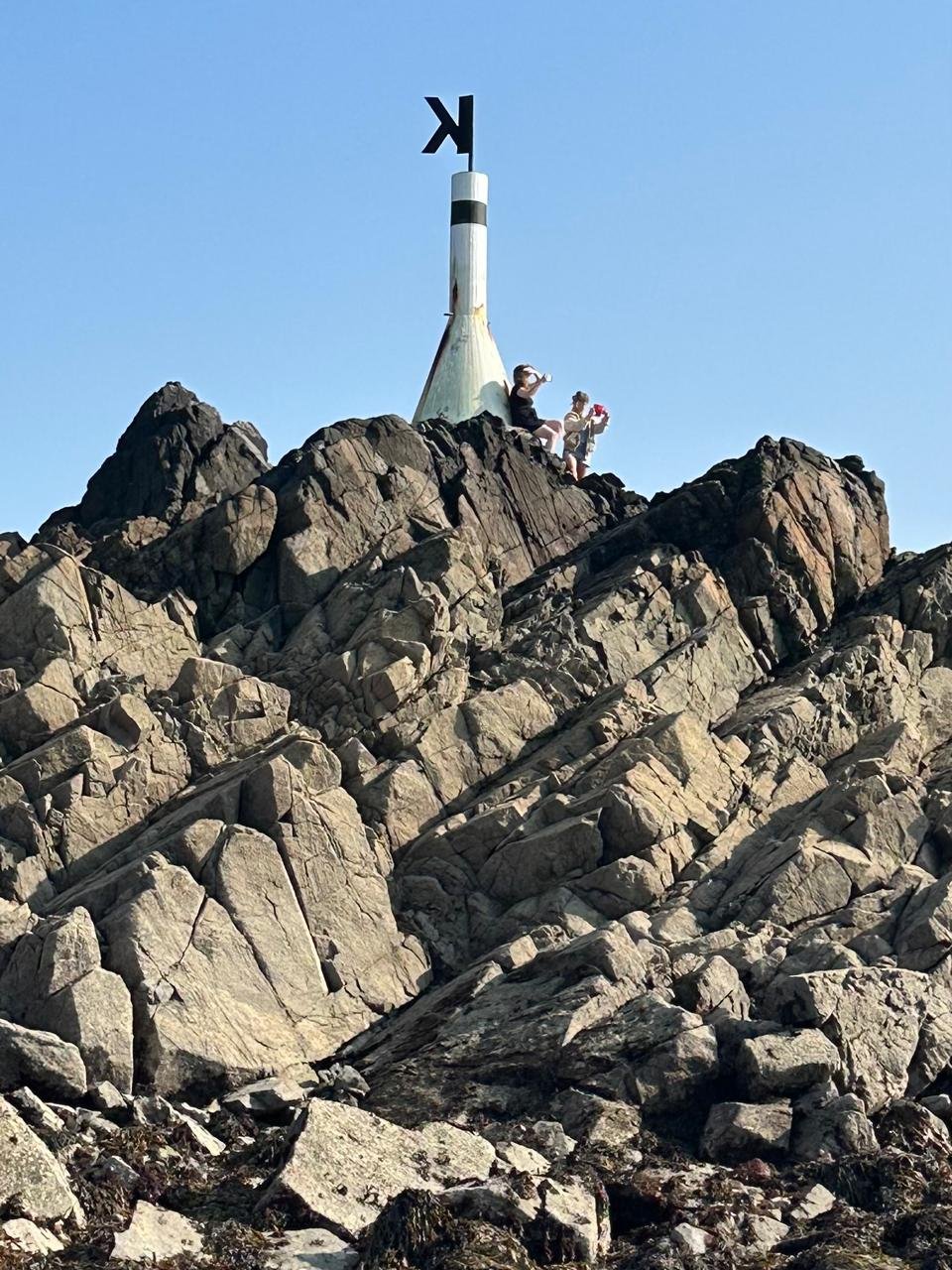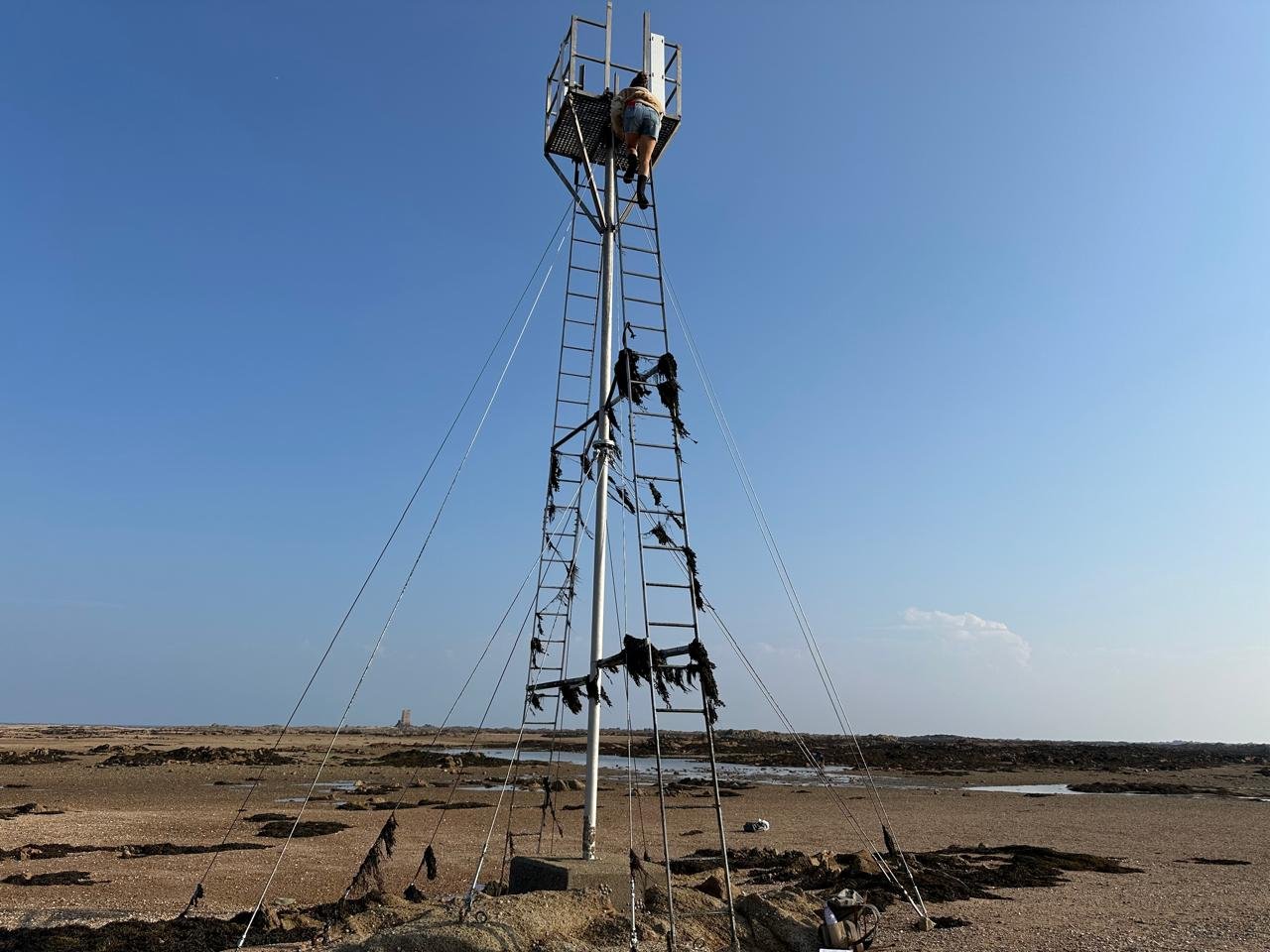Vraiqu’sie: Field trip to Karame Beacon
20 September 2024, Written by Margarida Lourenco Olivier
It was a perfect Friday in late September—the kind of day where the sun hangs low, casting a golden light over La Rocque beach. The warmth of summer still lingered in the air as we gathered at Seymour Slipway for our second Vraiqu’sie research trip. The pull of the ocean at low tide had drawn not only us but many others eager to explore the coastline before autumn’s cool breath swept in.
We were fortunate to have Dr. Paul Chambers, Head of the Aspiring Jersey Island Geopark, as our guide. His deep, personal connection to the landscape promised insights into the secrets hidden in the rocks and tide pools. At around 2 pm, just an hour before one of the lowest tides of the month, we set out—ready to explore this ancient coastline. Paul mapped out our route carefully, highlighting the best ways to navigate the rugged terrain. His deep understanding of the area's geography was immediately clear as we moved, observing the rocks, seaweed, and pools around us.
The first seaweed species we encountered in abundance were bladder vraic and serrated vraic, their leathery fingers draped over rocks and sand. Occasionally, we spotted strands of bootlace seaweed—its long, cord-like structure trailing through the water, twisting and curling like nature’s own delicate ropes. As we walked further, the low tide revealed passages between rocks, leading us to crystal-clear pools filled with living seaweed—a treasure trove of marine life exposed by the retreating waters.
I had worn sandals, curious about how the water would feel underfoot, and was pleasantly surprised at the warmth of the wet sand and tidal pools. As we waded through, Paul explained the seasonal shifts in seaweed species, pointing out how green seaweed fades as summer ends and red and brown seaweed takes its place. In the shallower pools, beautiful young sugar kelp swayed gracefully, their golden-brown blades dancing in the water like underwater ribbons, while carpets of seagrass—once absent for over 15 years—had begun to grow back, reclaiming their place on the shoreline. There was something rhythmic, almost poetic, about this natural cycle—the constant ebb and flow, much like the changing tides themselves, signalling the transition from one season to the next.
One of the highlights of the trip was discovering the man-made pathways carved into the rock centuries ago. These were the remnants of old vraicing routes, used by generations of Islanders who harvested seaweed to fertilize their fields. Paul’s words painted vivid images of horse-drawn carts and community labour, everyone working together to gather as much seaweed as they could before the tide reclaimed the land. It struck me then—how these ancient practices, born of necessity, were not only a means of survival but a testament to the deep connection people had with the rhythms of nature and the land.
As we approached Seymour Tower, a place I had never ventured to before, we marvelled at the sea grass that had begun to re-establish itself along Jersey’s shores. Paul spoke of how, despite invasive species threatening the local ecosystem, this resurgence was a hopeful sign that with careful intervention, nature could heal.
But not everything was hopeful. Paul shared the rising concern about warming waters, allowing certain invasive species to thrive at the expense of the native seaweed. It was a sobering reminder that the sea, while beautiful and powerful, is also vulnerable to the changes we are bringing to it.
The temperature equipment that Paul needed to recover was hidden beneath a rock—a landmark only he could recognize from years of walking this coast whilst low water fishing with his father. Watching him search for it, I was reminded of how much knowledge is passed down, from generation to generation, through hands-on experience. In an era dominated by technology and data, Paul’s ability to read the land and sea in such an intuitive way felt like a rare and invaluable skill, one that we risk losing if we don't continue to honour it.
After retrieving the equipment, we ventured further, seeking out the larger kelp forests. We re-joined the same group of explorers at Karame Beacon. Climbing up the beacon, we paused to bask in the sun and take in the expansive view, watching everyone as they explored the rockpools below. From this elevated vantage point, we were struck by the sweeping panorama of land and sea, appreciating the intricate route we had covered. Below and around the beacon, we discovered stunning live kelp attached to the rocks and gracefully submerged in the water—some reaching lengths of up to 1.5 meters, their autumnal colours glistening in the sunlight. The kelp’s smooth, flat surfaces undulated like a mythical creature’s tail, evoking visions of sculptures that could capture their fluidity and elegance.
As the tide began its slow return, we made our way back toward the slipway, passing fields of shells and sandbanks filled with life. Razor clams shot jets of water up from the sand at our feet, a playful reminder of the teeming world just beneath the surface. Halfway between the shore and the tower, we came to the rescue tower, stark white against the horizon, built to rescue those stranded by the notoriously fast-moving tides. We climbed to the top, pausing to take in the expansive views stretching from Mont Orgueil to the east to Le Hocq in the west.
Just near the rescue tower, Paul pointed out a split quern stone—a reminder of Jersey’s Neolithic past. Standing there, on a beach once inhabited by our ancient ancestors, I was struck by the sense that this place, now so seemingly wild and untouched, had been a place of human activity, harvesting, and life. In a distant time, this shoreline might have been connected to France itself, a link to the broader world beyond the island.
As we concluded our walk, we headed to the Seymour Pub to rest and reflect. Sitting outside, watching the modern oyster tractors at work, I couldn’t help but think of the carts that once carried vraic from this same slipway—two different eras, linked by the land and sea.
We talked about the beauty of traditions, the cyclical nature of life, and how the tides, like time, always bring things back full circle. The ancient practice of vraicing, like so many other traditions, was rooted in community, in working together with nature rather than against it. As the sea came to reclaim the land once again, I felt a deep appreciation for those who had walked this path before us and a sense of responsibility to ensure that these stories, and the knowledge they contain, are not washed away.




















